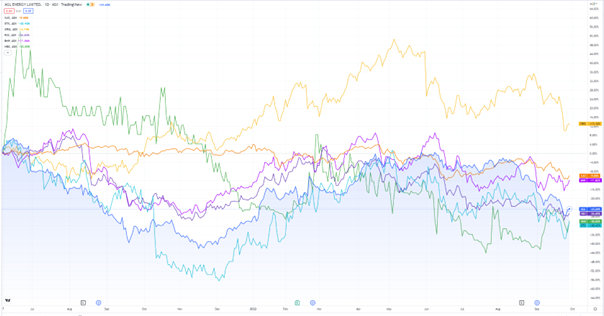AGL Energy [ASX:AGL] today released its FY23 Guidance and a Review of Strategic Direction for 2023, revealing the intention to leave ‘coal-fired generation by the end of FY35’ as it races to secure a position as one of the top providers of low-carbon energy in Australia.
The energy stock was mostly flat on the release; shares were worth $6.63 on Thursday morning.
AGL’s share price has fallen more than 14% over the course of September, although it retains a 13% gain over the last 52-week cycle.

Source: Trading View
AGL’s new strategies and FY23 guidance
With the world set to reach net-zero carbon emissions by 2050, AGL has decided to take necessary steps to accelerate initial plans to reconfigure its energy output and pull out of the coal-powered energy market by 2035.
AGL’s early closure of its Loy Yang A Power Station — a whole 10 years earlier than originally planned — has the company anticipating its yearly greenhouse gas emissions can be cut from 40 million tonnes to the global net zero target put in place by the Paris Agreement in 2016.
In addition, AGL also said that it plans to grow a portfolio of decarbonised assets, tightening its renewable options and capacity.
AGL intends to chase customer demand with up to 12 GW new generation capacity — incurring a total investment of up to US$20 billion before 2036.
An interim target of 5 GW new renewables has also been set for 2030, increasing the original 3.2 GW target.
Funding this investment will be through varied existing assets, offtakes, and partnerships with like-minded companies.
On the topic of funding, AGL also updated its FY23 earnings guidance.
Underlying net profit is forecast between $200 million and $230 million, and EBITDA between $1,250 million and $1,450 million.
AGL’s Chair, Patricia McKenzie, stated:
‘AGL is committing to an ambitious but achievable strategy to deliver a responsible and accelerated low carbon future. We are aiming to reshape our energy portfolio into a cleaner and more flexible one, transitioning away from coal and focusing on new renewable and firming capacity.
‘This represents one of the most significant decarbonisation initiatives in Australia.’
AGL’s incoming Interim CEO Damien Nicks added:
‘The targeted earlier closure of Loy Yang A Power Station will avoid up to 200 million tonnes of greenhouse gases being emitted compared to the previous Loy Yang A Power Station closure date.
‘With the closures of Bayswater and Loy Yang A, we have also announced an ambition to meet projected customer energy demand with up to 12 GW of new firming and renewable assets before 2036.
‘AGL’s future portfolio will be “demand driven”, meaning we will focus on capacity that responds to what our customers need — with the majority of new supply anticipated to be from wind and storage, including batteries.’
AGL commits to net zero
AGL says it’s focused on providing affordable energy while supporting electrification for the economy’s low-carbon future.
In doing so, AGL believes it has an ‘attractive opportunity’ to participate in Australia’s energy transition while providing capital for its shareholders.
McKenzie said:
‘We are excited by what is before us and believe our shareholders will benefit from a stronger and more sustainable business that will be uniquely positioned in the transitioning energy market.
‘Today’s announcement recognises the increasing ESG pressure from investors and consumers that has been affecting our business and we expect to be able access a wider pool of capital and attract new investors, which will ultimately result in a lower cost of capital and a more sustainable business.’
Ways to play the EV revolution
The EV market is rapidly expanding, boosted further by government initiatives and funding programs supporting production across the globe.
But our energy expert, Selva Freigedo, thinks the global transition to EVs means the industry faces a supply crunch, which can send prices for battery materials soaring even higher in 2022 and beyond.
If you’d like to know more, I suggest checking out Selva’s battery tech metals report.
Find out more about ‘Three Ways to Play the Great EV Battery Race’ here.

